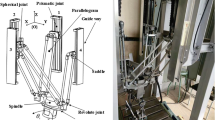Abstract
A novel 6-SSP parallel machine tool and a novel 4SPS+UPU parallel machine tool are presented, and a novel CAD approach is proposed to machine a 3D free-form surface in its normal direction by using the two parallel machine tools. First, by adopting the CAD geometry constraint and dimension-driving technique, the simulation mechanisms of a 6-SSP parallel manipulator with 6-DOF and a 4SPS+UPU parallel manipulator with 5-DOF are created. Second, a 3D free-form surface and a guiding plane of tool path are constructed above the moving platform of the two simulation mechanisms. Third, the tool axis of simulation parallel machine tool is retained perpendicular to the 3D free-form surface. In the light of two prescribed tool paths, the driving limbs and the pose of the moving platform of parallel machine tools are solved automatically and visualized dynamically.
Similar content being viewed by others
Abbreviations
- s :
-
The 3D free-form surface
- B :
-
The base
- M :
-
The simulation parallel machine tool
- P 0 :
-
The guiding plane of tool path curve
- P:
-
The prismatic joint
- S:
-
The sphere joint
- U:
-
The universal joint
- T :
-
The cutter tool
- p :
-
The tip of tool
- g :
-
The guiding line of tool
- dx,dy:
-
Two driving dimensions
- ⊥,//:
-
Perpendicular and parallel symbols
- F :
-
The numbers of degree of freedom
- r i :
-
The driving limb i=1, 2,…, 6
- m :
-
The moving platform
- l i :
-
Sideline of m
- w :
-
The prescribed tool path curve
- L :
-
Sideline of base B
- u j :
-
Prescribed spline on P j j=1, 2, … k
- P j :
-
Datum plane for sketching spline u j
- o :
-
The central point of m
- O :
-
The central point of base
- α,β,γ:
-
The 3 orientation components of T
- c i :
-
Binary link i=1, 2, …, 6
- XoYo,Zo:
-
The 3 translation components of m
- F o :
-
Local redundant degree of freedom
References
Steve K, Arthur G (1990) CNC technology and programming. McGraw-Hill, New York
Roger SP, John EW (1977) Numerical control and computer aided manufacturing. Wiley, New York
Chen YD, Ni J, Wu SM (1993) Real-time CNC tool path generation for machining IGES surfaces. ASME J Eng Ind 115:480–486
Kim BH, Choi BK (2000) Guide surface based tool path generation in 3-axis mill: an extension of the guide plane method. Comput Aided Des 32(3):191–199
Elber G, Cohen E (1994) Tool path generation for freeform surface models. Comput Aided Des 26(6):490–496
Lee K (1999) Principles of CAD/CAM/CAE systems. Addison-Wesley, Boston
Beckert BA (1996) Venturing into virtual product development. Comput Aided Eng May:45–50
Koparkar PA, Mudur SP (1986) Generation of continuous smooth curves resulting from operations on parametric surface patches. Comput Aided Des 18(4):193–206
Farin G (1990) Curves and surfaces for computer-aided geometry for design. Academic, San Diego, CA
Hartley PJ, Judd CJ (1980) Parameterization and shape of B-spline curve for CAD. Comput Adied Des 12(5):235–238
Shu Z, Heisel U (2003) Parallel machine tool. Mechanical Industry Press, Bejing, China
Huang Z, Fang YF (1998) Mechanism theory of spatial parallel robot and control. Mechanical Industry Press, Bejing, China
Gosselin CM, Pereault L, Vaillancourt CH (1995) Simulation and computer-aided kinematic design of three-degree-of freedom spherical parallel manipulators. J Robot Syst 12(12):857–869
Lu Y (2004) Using CAD functionalities for the kinematics analysis of spatial parallel manipulators with 3-, 4-, 5-, 6-linearly driven limbs. Mach Mech Theory 39(1):46–60
Lu Y (in press) Using CAD variation geometry and analytic approach for solving kinematics of a novel 3-SPU/3-SPU parallel manipulator. Trans ASME, J Mech Des
Lu Y (2002) Computer simulation applied to an orthogonal three-rod machine tool for machining a complicated three-dimensional surface. Int J Mach Tool Manuf 42(11):1277–1284
Lu Y, Tatu L (2002) Computer simulation approach to machining complicated shape on orthogonal 6-rod machine tool. Int J Mach Tool Manuf 42(4):441–447
Lu Y (2005) Computer-aided geometric machining of a 3D free surface using a 3-UPU spatial parallel machine tool. Int J Adv Manuf Technol 26(10):1018–1025
Author information
Authors and Affiliations
Corresponding author
Additional information
This project is supported by NSFC 50575198
Rights and permissions
About this article
Cite this article
Lu, Y. Simulation of machining 3D free-form surface in normal direction using 6-SSP and 4SPS+UPU parallel machine tools. Int J Adv Manuf Technol 33, 1180–1188 (2007). https://doi.org/10.1007/s00170-006-0547-x
Received:
Accepted:
Published:
Issue Date:
DOI: https://doi.org/10.1007/s00170-006-0547-x




